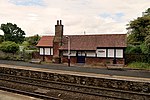Lindeth Tower
Buildings and structures in the City of LancasterFolly towers in EnglandGrade II listed buildings in LancashireSilverdale, LancashireTowers completed in 1842

Lindeth Tower is a Victorian folly in Silverdale, Lancashire, England. It is an embattled square tower of three storeys. It was built in 1842 by the Preston banker Hesketh Fleetwood. Elizabeth Gaskell stayed in the tower in the 1840s and 1850s and her novel Ruth was written there. Lindeth Tower is a Grade II listed building.
Excerpt from the Wikipedia article Lindeth Tower (License: CC BY-SA 3.0, Authors, Images).Lindeth Tower
Sand Lane, Lancaster Silverdale
Geographical coordinates (GPS) Address Website External links Nearby Places Show on map
Geographical coordinates (GPS)
| Latitude | Longitude |
|---|---|
| N 54.1603 ° | E -2.8265 ° |
Address
Sand Lane
LA5 0UA Lancaster, Silverdale
England, United Kingdom
Open on Google Maps










